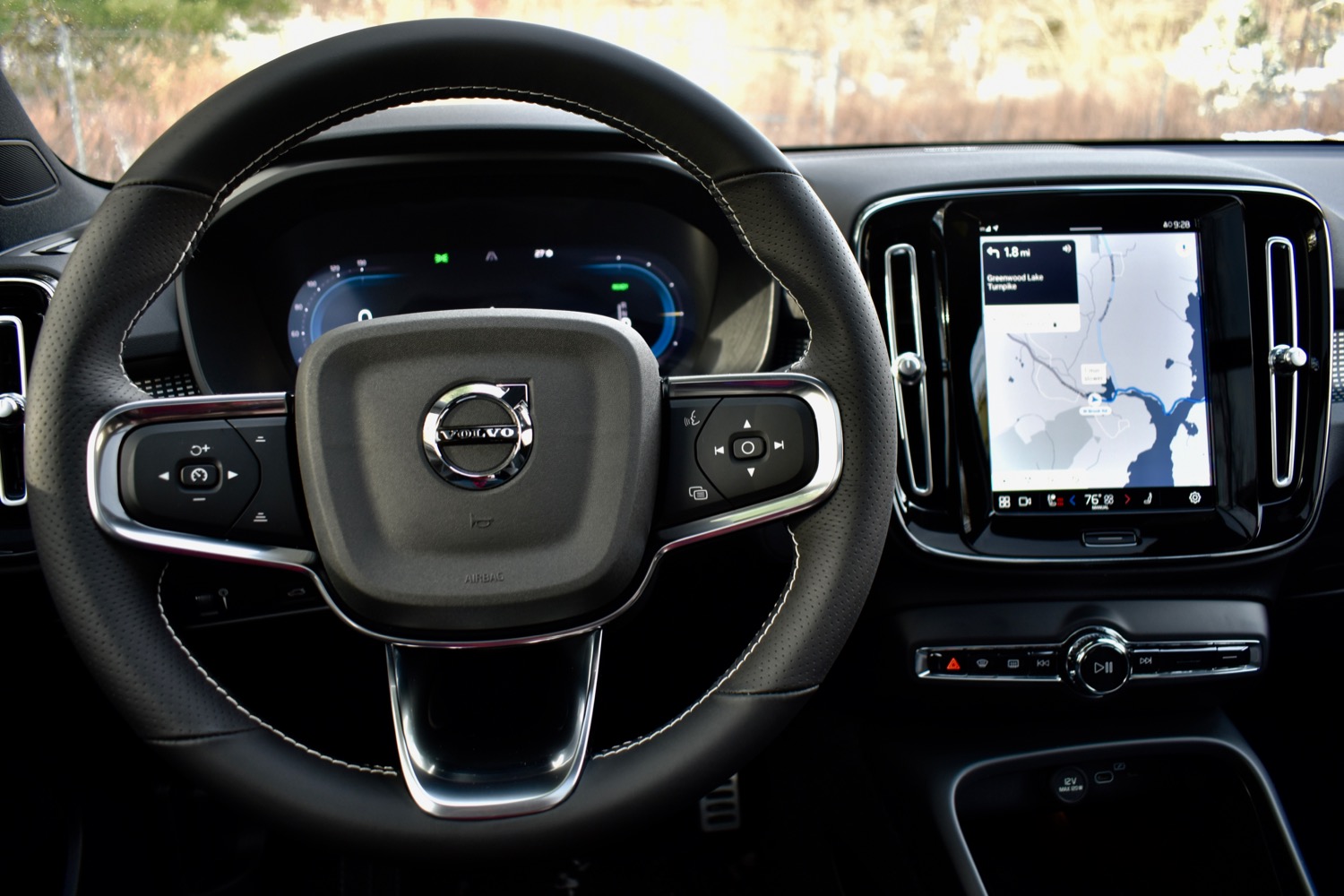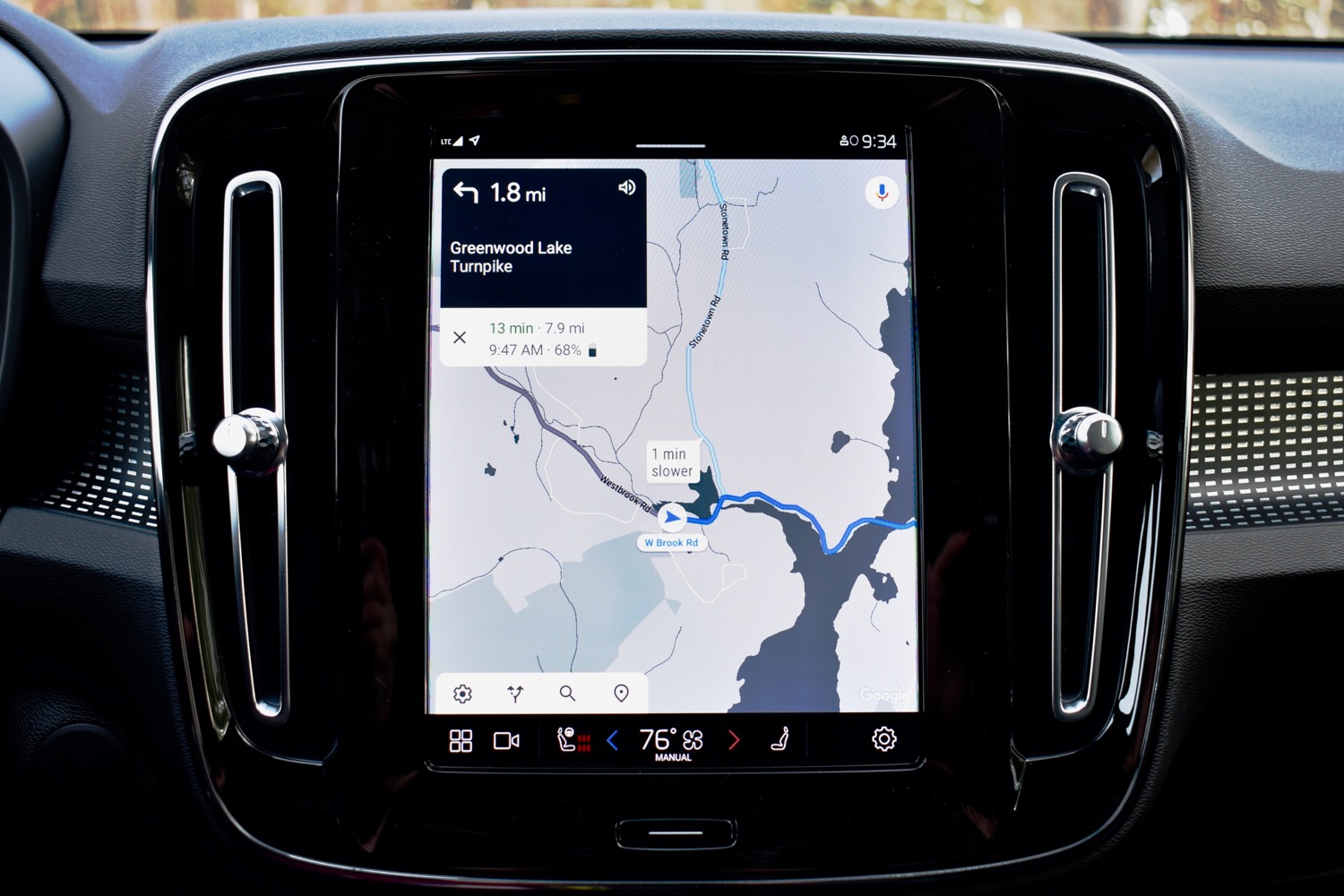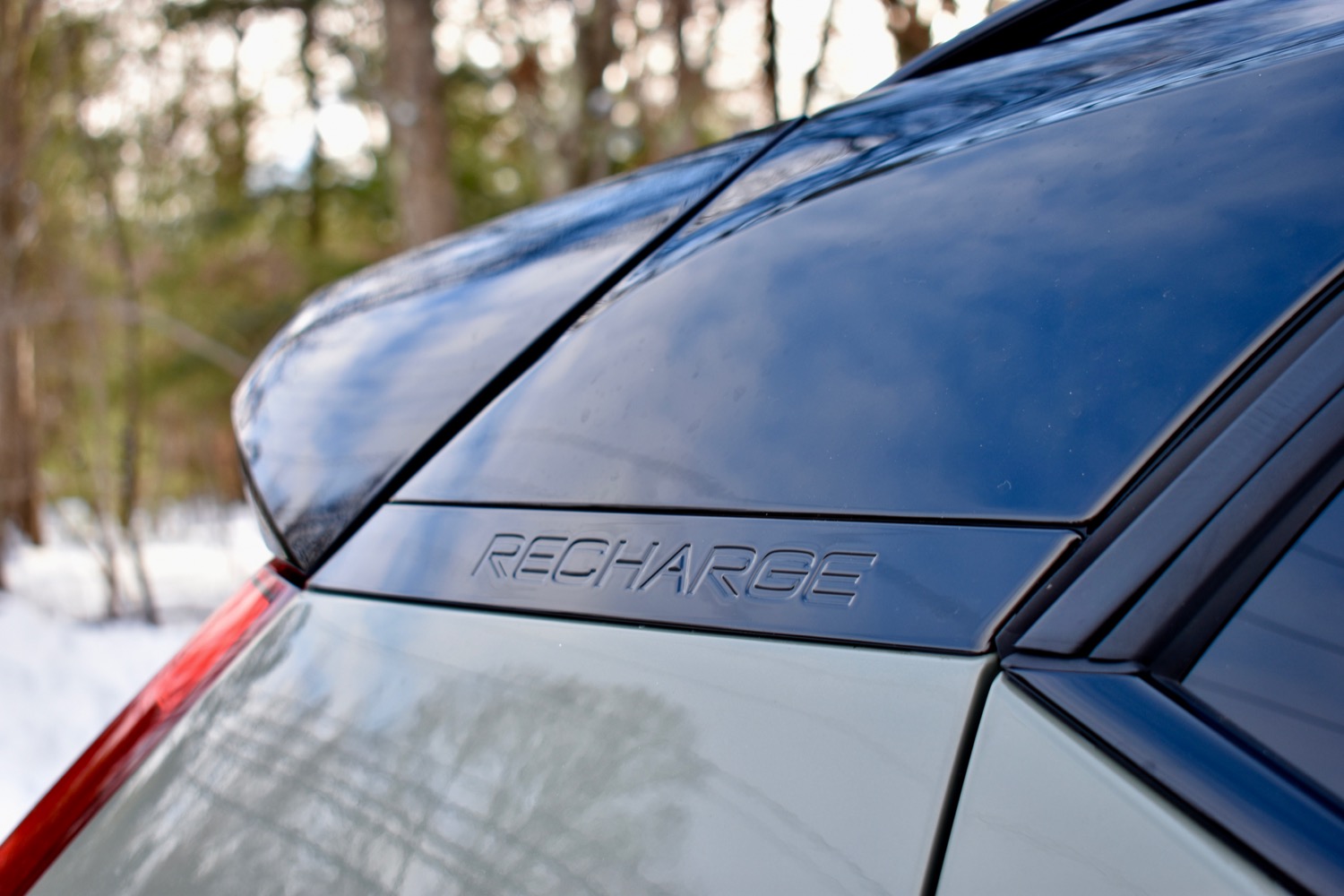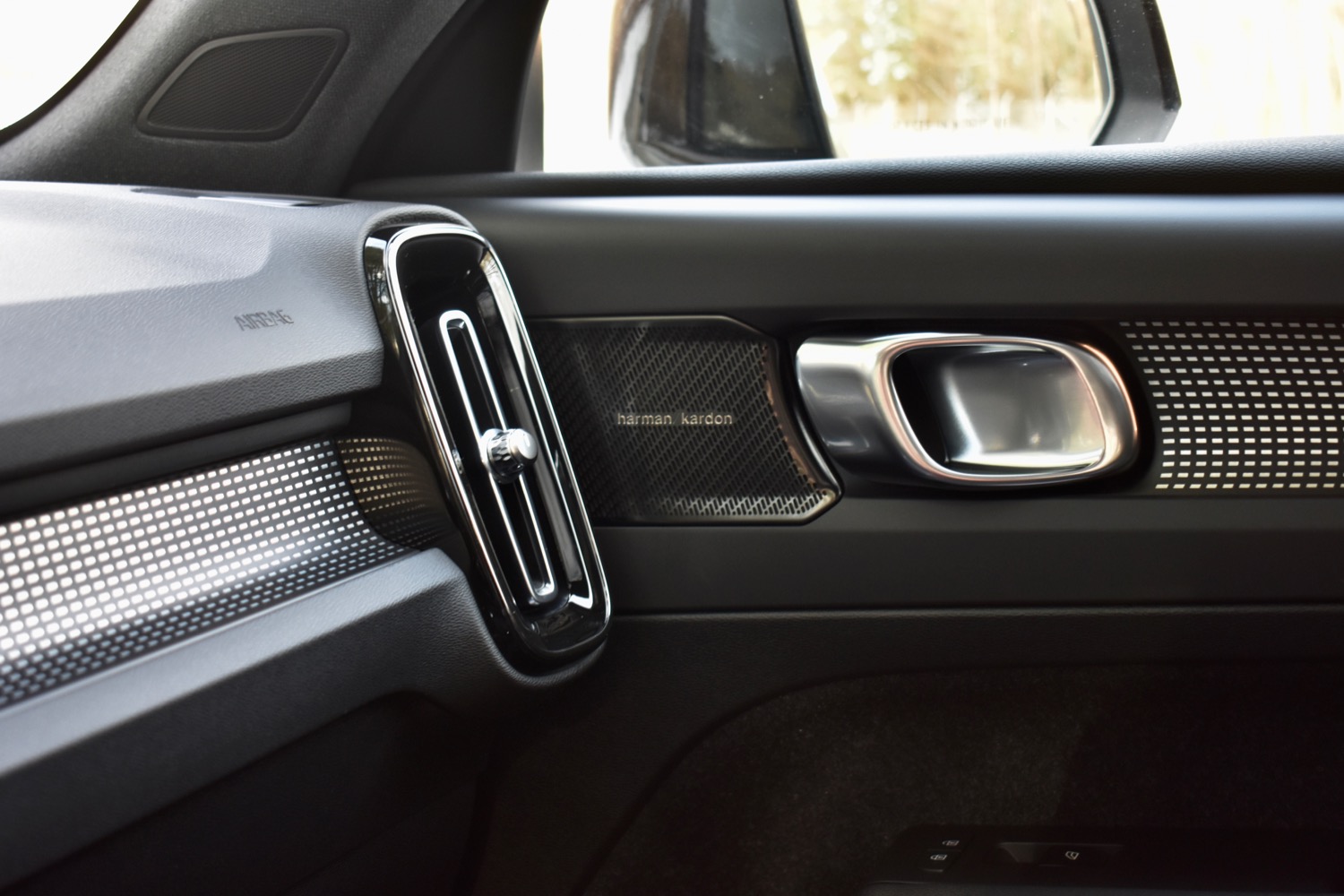Volvo has said it plans to move away from internal combustion, but right now it only sells one car without a gasoline engine: The 2021 Volvo XC40 Recharge.
The Recharge is an all-electric version of the Volvo XC40 crossover, which launched for the 2019 model year. While the gasoline XC40 competes with pint-sized utility vehicles from Audi, BMW, Mercedes-Benz, and Lexus, the Recharge’s size and premium branding make it a Tesla Model Y competitor. The Volvo may also be pitted against high-end versions of the Ford Mustang Mach-E, although price is really the only similarity between the two.
If you thought electric cars were just about saving the planet, note that the electric XC40 is substantially more powerful and quicker than the gasoline model. The Recharge also gets the latest Android Automotive OS infotainment system and an updated sensor suite for driver-assistance features — things you won’t get on the gasoline XC40 for the 2021 model year.
That tech comes at a price, though. The Recharge starts at $54,985—about $12,000 more than the top gasoline XC40 trim level. It’s also a bit higher than the base price of a Model Y but, unlike Tesla, Volvo still qualifies for the full $7,500 federal EV tax credit, which could erase that difference.
Design and interior
The XC40 Recharge looks virtually identical to the gasoline XC40. The main giveaways are a blanked-off grille and subtle “Recharge” badging. Recharge models are also sold exclusively with a black roof and mirror caps, as well as model-specific wheel designs. Other than that, the Recharge is an electric car that really flies under the radar. Even the charge port is hidden where a fuel filler would normally be.
That means you get a fairly traditional looking SUV, with a tall, upright profile. It’s quite a contrast to the sleeker-looking Model Y and Mach-E, which blur the line between SUV and station wagon.
The Ford and Tesla offer greater utility, however. While Volvo claims the Recharge has the same amount of passenger and cargo space as the gasoline XC40, the Mach-E and Model Y still have larger cargo areas, as well as more legroom in both rows. The Tesla also offers more headroom than the Volvo, as well as a third row of seats. The Volvo does sport a frunk, but it’s tiny.
The Recharge is an electric car that really flies under the radar.
Volvo tried to make up for this with some clever interior design features. Designers moved some of the speakers for the Harman Kardon audio system from the doors to the dashboard, making room for larger in-door storage bins. The center console also sports a removable trash bin, and a bag hook is built into the glovebox door.
The interior is also a nice place to be. Volvo achieved the minimalist look Ford and Tesla seemed to be going for, in part because designers resisted the temptation to slap a massive touchscreen in the middle of the dashboard. Materials feel suitably premium, although Volvo doesn’t offer full leather upholstery. Instead, you get a mix of nappa leather and Nubuck textile.
Electric and gasoline XC40 models are based on Volvo’s Compact Modular Architecture (CMA) platform, which is shared with the Polestar 2 electric car from Volvo’s new spinoff brand. The Recharge shares a lot more than just a basic platform with Polestar 2, as you shall see.
Tech, infotainment, and driver assist
The Recharge gets the Android Automotive OS infotainment system that debuted in the Polestar 2. Because it’s Android-based, the system has embedded Google apps. For example, Google Assistant and Google Maps are the default voice control and navigation apps, respectively. Android users can also sync their Google accounts to the car.
In the Recharge, the Android OS runs on a 9.0-inch central touchscreen and 12.3-inch digital instrument cluster. Apple CarPlay, Android Auto, and Bluetooth are included as well, but the default interface is still all Google. While the infotainment system worked well, if you’re not a fan of Android smartphones, it probably won’t be your cup of tea.
The small cubby ahead of the shifter includes a USB-C port with wire guide, and can be equipped with a wireless charging pad. However, Volvo didn’t include USB ports for the second row.
The infotainment system worked well, if you’re not a fan of Android smartphones, it probably won’t be your cup of tea.
As is typical for Volvo, the Recharge gets a laundry list of standard driver-assist tech, including forward-collision warning, lane-departure warning, lane-keep assist, blind-spot monitoring with rear cross-traffic alert, forward and reverse automatic emergency braking, a driver-alertness monitor, traffic sign recognition, run-off-road mitigation, and oncoming lane mitigation. Pilot Assist, which combines adaptive cruise control and automated lane centering for highway driving, is a paid extra.
Like the related Polestar 2, the XC40 Recharge can also use cloud-based data to improve the performance of its driver-assist tech, according to Volvo. It gets the automaker’s latest sensor suite, which is scalable for more advanced future driver aids, according to Volvo. The Recharge also boasts over-the-air (OTA) update capability for all vehicle software, which should make adding those new features easier.
Instead of pressing a button to start the XC40 Recharge, you just shift out of park. If the key fob is in the car, it will start. Volvo hasn’t said whether the XC40 Recharge will get the Digital Key feature launched in the Polestar 2, which allows a smartphone to be used in place of a key fob.
Driving experience
Also like the Polestar 2, the XC40 Recharge gets one electric motor per axle, enabling all-wheel drive. Output is about the same as the Polestar, at 402 horsepower and 486 pound-feet of torque.
While not intended as a performance car, the Recharge is one of the quickest cars Volvo makes. It will do zero to 60 mph in 4.7 seconds, 1.4 seconds quicker than the most powerful gasoline version of the XC40, according to the company. That’s also 0.1 second quicker than a Tesla Model Y Long Range or Ford Mustang Mach-E Premium, but Tesla and Ford also offer sportier versions that can reach 60 mph in just 3.5 seconds.
Aside from the robust acceleration, the rest of the XC40 Recharge driving experience is fairly relaxed. Like Volvo’s other recent models, the Recharge emphasizes smoothness and comfort over performance. We couldn’t take corners as aggressively in the XC40 as we could in the Mustang Mach-E, but the Volvo also lacked the Ford’s stiff ride. It’s a compromise many drivers will likely appreciate.
Unlike many electric cars, the XC40 Recharge is rated for towing. Its 2,000-pound towing capacity isn’t a lot, however. Tesla quotes a 3,500-pound towing capacity for the Model Y with the optional towing package.
Range, charging, and safety
The XC40 Recharge is only offered with one battery-pack size: 78 kilowatt-hours, with 75 kilowatt-hours of usable capacity. That affords a 208-mile range, which is unimpressive when the Tesla Model Y offers a 326-mile range for similar money.
The electric Volvo is equipped for DC fast charging at up to 150 kilowatts, allowing for an 80% charge in 40 minutes. Charging from a 240-volt AC Level 2 source takes eight hours. Helpfully, Volvo includes a cable that can plug directly into the 240-volt outlets used by large appliances, so if you’ve got one of those in your garage, you won’t need to install a dedicated charging station.
Like Volvo’s other recent models, the Recharge emphasizes smoothness and comfort over performance.
Crash-test ratings from the Insurance Institute for Highway Safety (IIHS) and National Highway Traffic Safety Administration (NHTSA) aren’t available yet, and ratings from the gasoline XC40 don’t apply to the electric model. Volvo made some changes to ensure good crash performance, including a battery safety cage and a new front crash structure designed to account for the lack of an engine.
Volvo offers a four-year, 50,000-mile basic warranty, a four-year, 50,000-mile powertrain warranty, and an eight-year, 100,000-mile battery warranty. Ford offers a shorter basic warranty term, but a longer powertrain warranty term, with the same battery warranty. Tesla matches Volvo in all three categories, although some Tesla vehicles get a 120,000-mile battery warranty term.
How DT would configure this car
Volvo makes things pretty simple, offering the XC40 Recharge in just a single trim level, with one powertrain and battery pack. On top of the standard features, we would add the $1,300 Advanced Package, which includes the Pilot Assist driver aid, a 360-degree camera system, wireless phone charging, and a 12-volt power outlet for the cargo area.
We would also add the electric heat pump ($350), which helps heat up the cabin more quickly on cold days, while also saving energy. We’d finish off with the Harman Kardon audio system ($800) and our test car’s Sage Green Metallic paint ($645), which is exclusive to the Recharge model. That brings the total price of our ideal XC40 Recharge to $58,080, before tax credits and other incentives.
Our take
The XC40 Recharge may be the first mass-market electric car to wear the Volvo badge, but it’s really the Swedish automaker’s second all-electric model. The Polestar 2 may be sold under a different brand, but it shares a platform, powertrain, and infotainment system with the Recharge.
The Polestar 2 impressed us, and many of its good attributes carry over to the Recharge. The Volvo has the same overall feeling of quality refinement, but with a more laid-back character. It’s a good counterpoint to the sporty Polestar, and a solid “first” effort at an electric car, but it should have been more.
The Recharge falls short of the Tesla Model Y and Ford Mustang Mach-E on range and utility, but has a much nicer interior, and can keep up with comparably priced versions of the Tesla and Ford in a zero-to 60-mph sprint race. The Volvo also feels more like a normal car.
If all you want is basic zero-emission transportation, the Chevrolet Bolt EV, Hyundai Kona Electric, and Nissan Leaf offer more range at a much lower price. None of those are available with all-wheel drive, however. That’s also the case for the recently-launched Volkswagen ID.4, although the VW will be available with all-wheel drive eventually.
The XC40 Recharge is still a good car, and worth considering for those willing to spend a little extra for more tech and better performance. That we consider the Volvo merely a solid contender, rather than an outright champion, shows how fast the EV competition is moving.
Should you get one?
Yes. Volvo’s electric future looks bright.







